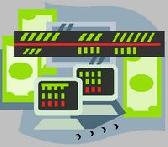
 |
|
| Financial Terms | |
| Make-to-order |
|
Information about financial, finance, business, accounting, payroll, inventory, investment, money, inventory control, stock trading, financial advisor, tax advisor, credit.
Main Page: credit, accounting, business, stock trading, payroll, money, tax advisor, inventory control, |
Definition of Make-to-order
Make-to-orderA production scheduling system under which products are only
Related Terms:Buy limit orderA conditional trading order that indicates a security may be purchased only at the designated Cross-border riskRefers to the volatility of returns on international investments caused by events associated Day orderAn order to buy or sell stock that automatically expires if it can't be executed on the day it is entered. Economic order quantity (EOQ)The order quantity that minimizes total inventory costs. Fill or kill orderA trading order that is canceled unless executed within a designated time period. Limit orderAn order to buy a stock at or below a specified price or to sell a stock at or above a specified Limit order bookA record of unexecuted limit orders that is maintained by the specialist. These orders are  Make a marketA dealer is said to make a market when he quotes bid and offered prices at which he stands Market orderThis is an order to immediately buy or sell a security at the current trading price. Negotiable order of withdrawal (NOW)Demand deposits that pay interest. Open (good-til-cancelled) orderAn individual investor can place an order to buy or sell a security. That Pecking-order view (of capital structure)The argument that external financing transaction costs, especially Sell limit orderConditional trading order that indicates that a, security may be sold at the designated price or Stop-loss orderAn order to sell a stock when the price falls to a specified level. Stop order (or stop)An order to buy or sell at the market when a definite price is reached, either above (on a Stop-limit orderA stop order that designates a price limit. In contrast to the stop order, which becomes a  Make-readySee set-up. economic order quantity (EOQ)an estimate of the number engineering change order (ECO)a business mandate that changes the way in which a product is manufactured or a job order cost sheeta source document that provides virtually job order costing systema system of product costing used make-or-buy decisiona decision that compares the cost of open purchase orderinga process by which a single purchase ordering costthe variable cost associated with preparing, order pointthe level of inventory that triggers the placement special order decisiona situation in which management must determine a sales price to charge for manufacturing or service jobs outside the company’s normal production/service market economic order quantityorder size that minimizes total inventory costs.  pecking order theoryFirms prefer to issue debt rather than equity if internal finance is insufficient. Make-Work ProjectA project, such as digging holes and filling them up again, that has no useful purpose other than to make work. Discrete order pickingA picking method requiring the sequential completion of Make-to-stockA production scheduling system under which products are completed Order penetration pointThe point in the production process when a product is Order pickingThe process of moving items from stock for shipment to customers. money orderA guaranteed form of payment in amounts up to and including $5,000. You might request a money order in order to pay for tuition fees at a university or a college, or for a magazine subscription. Materials requirement planningComputer-based systems that plan backward from the production schedule SUM-OF-THE-YEARS’ DIGITSAn accelerated depreciation method that makes the sum of the digits in an asset’s expected Product marketA business’s investment in technology, people and materials in order to make, buy and sell products or services to customers. capital investment analysisRefers to various techniques and procedures Long positionOutright ownership of a security or financial instrument. The BackdatingA procedure for making the effective date of a policy earlier than the application date. Backdating is often used to make the age of the consumer at policy issue lower than it actually was in order to get a lower premium. BeneficiaryThis is the person who benefits from the terms of a trust, a will, an RRSP, a RRIF, a LIF, an annuity or a life insurance policy. In relation to RRSP's, RRIF's, LIF's, Annuities and of course life insurance, if the beneficiary is a spouse, parent, offspring or grand-child, they are considered to be a preferred beneficiary. If the insured has named a preferred beneficiary, the death benefit is invariably protected from creditors. There have been some court challenges of this right of protection but so far they have been unsuccessful. See "Creditor Protection" below. A beneficiary under the age of 18 must be represented by an individual guardian over the age of 18 or a public official who represents minors generally. A policy owner may, in the designation of a beneficiary, appoint someone to act as trustee for a minor. Death benefits are not subject to income taxes. If you make your beneficiary your estate, the death benefit will be included in your assets for probate. Probate filing fees are currently $14 per thousand of estate value in British Columbia and $15 per thousand of estate value in Ontario. Insured Retirement PlanThis is a recently coined phrase describing the concept of using Universal Life Insurance to tax shelter earnings which can be used to generate tax-free income in retirement. The concept has been described by some as "the most effective tax-neutralization strategy that exists in Canada today." Related to : financial, finance, business, accounting, payroll, inventory, investment, money, inventory control, stock trading, financial advisor, tax advisor, credit. |